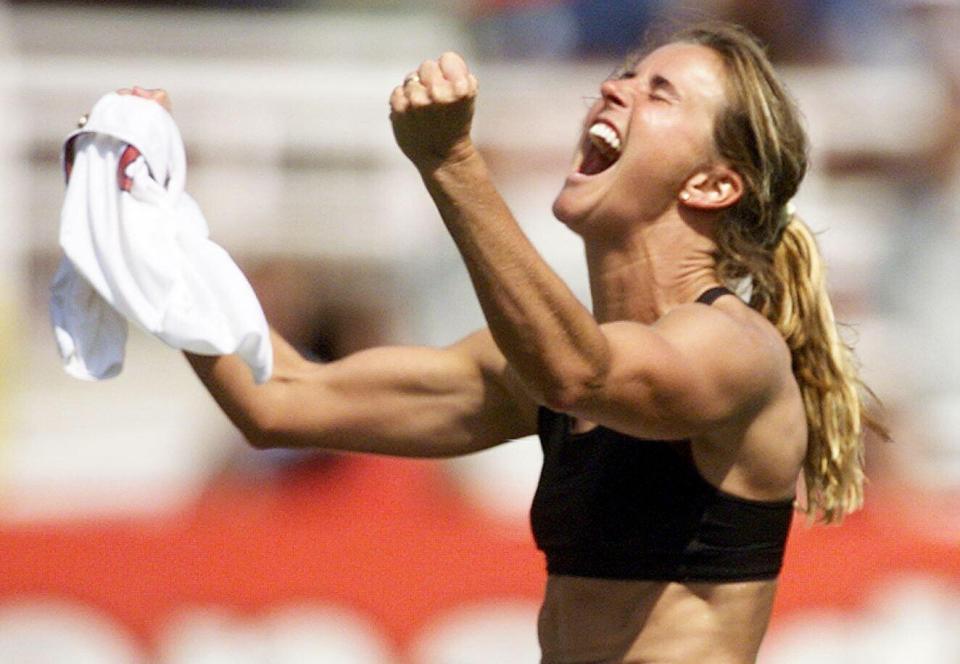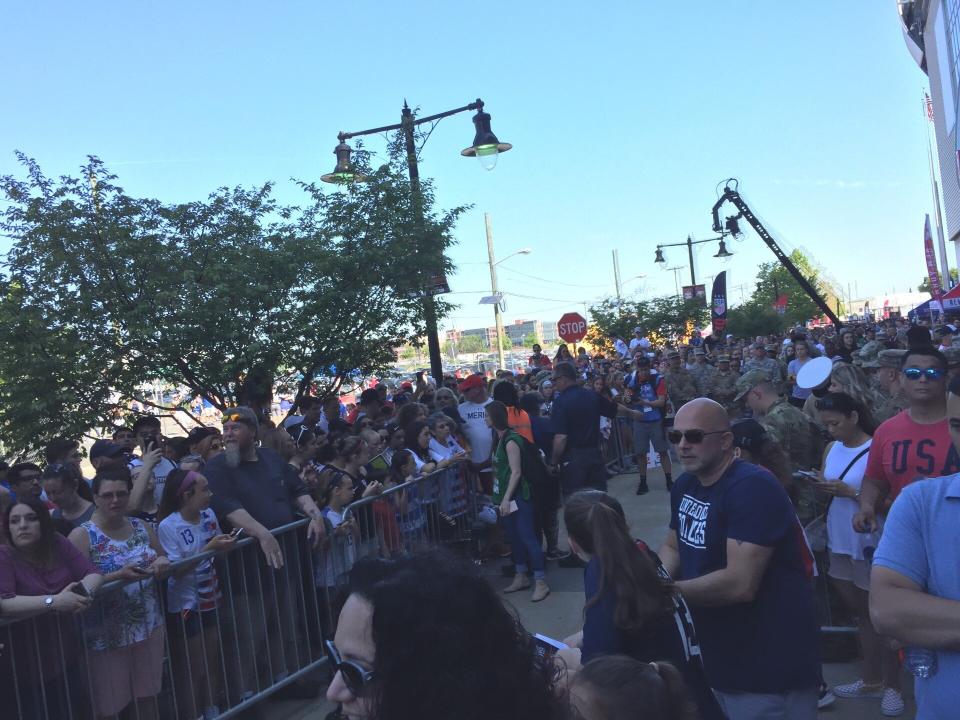How legacy of 99ers lives on in current USWNT
NEW YORK — It may have been the most transformative traffic jam in sports history. On June 19, 1999, to many the day women’s soccer arrived in America, thousands clogged the concrete maze around Giants Stadium. They painted faces and torsos and cars, World Cup kickoff mere hours away. They grilled meat, hung banners, waved flags, juggled balls. And somewhere among them, amid the expectation-smashing overflow of humanity and automobiles, under a beaming North Jersey sun on that momentous afternoon nearly 20 years ago, was an 11-year-old Tobin Heath.
She had journeyed to the Meadowlands with club teammates. Thrown a Mia Hamm jersey over her slender shoulders. Found a slab of grass spacious enough to host something resembling a pickup game, and done what any self-described “cocky kid” would have. “I remember pulling out all my tricks, and showing all my skills,” Heath recalls of the prematch kickabout. Her motivation?
Well, her idols were preparing to play in front of 79,000 fans several hundred feet away.
“Oh, if somebody sees me,” she thought, “I’m good enough to play out there.”
She wasn’t, of course – not yet, anyway. Not quite World Cup-caliber as a pre-teen. But the “99ers” made millions of young girls believe they could be. That they, too, could one day star for the USWNT. That they, the adoring fans who shrieked for everything from players’ autographs to match-worn boots, could one day have subsequent generations clamoring for theirs.
And as the 20th anniversary of that glorious summer approaches, the best evidence of the 99ers’ inspirational faculties might just be Heath and the 22 other women preparing for their own World Cup two decades later.
From Amagansett, New York to Salina, Kansas, from Peachtree City, Georgia to the Rose Bowl’s boundless bleachers, members of the current U.S. women’s national team watched in ‘99. And many encountered some version of the thought 10-year-old Alex Morgan had as Hamm and 19 other trailblazers captivated a nation:
“I wanna do that.”

The daughters of ‘99
Christen Press remembers nothing about the 1999 World Cup final. Not the 120 tense minutes, nor Brandi Chastain’s winning penalty, nor the shirtless celebration. But she has a photo, snapped from the Rose Bowl stands, three weeks after Heath roamed the Meadowlands parking lots. There are friends and family members. And there is 10-year-old Christen, face lathered in red, white and blue, headband and all.
“And I definitely can see in my face that that was a very impactful moment for me,” Press says now. “I never remember being like, ‘I want to be on the national team.’ But when I look at that photo, I see it.”
Press is one of 12 U.S. players heading to France who were at least 10 years old on July 10, 1999 — perhaps not old enough to comprehend the long-term magnitude of the first Women’s World Cup on American soil. But old enough to be impressionable. Megan Rapinoe, who turned 14 during the tournament, remembers a “wow” moment. Morgan, who lived 20 minutes from the Rose Bowl, remembers “inspiration.”
“I was like, ‘I want to be them when I grow up,” Morgan said earlier this year. “I want to be Mia, I want to be Brandi, I want to be [Kristine Lilly], I want to be Julie [Foudy]. They just were these badass group of women. I mean, I had never seen female athletes on TV in that way. … Thinking about that gives me chills.”
Ali Krieger, then 14, attended the thrilling quarterfinal win over Germany in a Hamm jersey and face paint. “It was kind of my ah-ha moment, watching them,” she tells Yahoo Sports. “Sitting up there in the stands, looking down at these powerful, badass women was pretty incredible for me to see. … I really wanted to pursue this career because of them.”
A week later, 10-year-old Kelley O’Hara watched the final with family at a hometown pizza joint in Georgia. Her parents actually dragged her to church, and therefore away from the penalty shootout. But the whole tournament, she says, “inspired me to believe I could do anything, and be there someday.”
Says Allie Long, then 11, whose family gathered around a TV on Long Island: “I remember that exact moment when they won. And it’s definitely been a memory I hold onto. It’s what has lit a fire in me to achieve that one day.”
And Carli Lloyd, then 16, speaking on Good Morning America last month: “Growing up, soccer was my passion. It’s something that I wanted to do. I didn’t know if that dream was attainable. Being able to watch the ‘99 team capture their gold medal, win their world championship, really inspired me.”
The next generation
The 1999 World Cup was so monumental, such a sporting landmark, that it has come to delineate soccer generations. And the 2019 World Cup will welcome a new one to the spotlight. A generation that largely learned about its heroes and heroes’ heroes through documentaries and magazine clippings. One that has soaked up story after story about the women who paved the way for it, but didn’t experience the paving first-hand.
Sam Mewis, who was 6 at the time, swears she did. She would fight with her sister for Hamm’s No. 9 when it came time to pick jersey numbers on youth teams. She had posters and VHS tapes. “Believe it or not, I think I remember it,” she says of ‘99. “I have some pretty vivid memories with my family watching in the living room. And I don’t think I really grasped what it meant. But I do think that as I grew up, I had those memories, and I kind of realized that professional women’s soccer was a thing, and that I could maybe play for the national team.
“That was really important validation for my dreams. A lot of young kids were like, ‘I’m gonna be a professional basketball player, professional football player.’ Having the 99ers to trailblaze and make [soccer] a possibility was really important for me.”

For the rest of the current squad’s 25- and 26-year-olds, memories are a bit fuzzier. Morgan Brian admits to having no recollection of actually watching the games. But she ended up with ‘99-related magazines all over her childhood bedroom. Abby Dahlkemper, who also carries no recollection, has watched the 99ers’ documentary, Dare To Dream, multiple times. Emily Sonnett’s Olympic Development Program team used to watch it repeatedly on bus trips through the south, pausing only for stops at Bojangles. Lindsey Horan, “a huge YouTube fanatic,” surely came across it and many other 1999 highlight reels as well.
Another thread that strings together generations is the 99ers’ continued presence in American soccer. Rose Lavelle was only 4 in 1999. But she was 8 when the U.S. hosted another World Cup in 2003, and 9 when the national team came to her hometown, Cincinnati, for a friendly. In ‘03, after a U.S. semifinal loss to Germany, she had sulked up to her bunk bed and cried all night. But when the likes of Hamm, Lilly and Foudy came to Paul Brown Stadium the following year, Lavelle says, “Being able to watch them in person was just so surreal, and made me realize I wanted to be in their shoes one day.”
Lavelle also had Heather Mitts, a fellow Cincy native, to look up to when Mitts broke into the national team around the turn of the century. Lavelle would attend Mitts’ soccer camps, and has “a trillion signed balls.” Tierna Davidson, meanwhile, met Chastain growing up in the Bay Area. The youngest member of the current roster, Davidson was 10 months old in ‘99. But Chastain was her route into the history behind the jersey she now wears.
Because the legacy of the 99ers has been preserved, it has continued to stimulate dreams – and could continue stimulating them for years to come.
The torch-passing
The concept of a soccer tournament galvanizing millions of young girls was always a bit abstract. It had been baked into the 1999 World Cup organizing committee’s mission statement, summarized by president Marla Messing prior to the tournament: “To stage a breakthrough event for women’s sports, and to inspire the next generation of female athletes.” But few, if any, knew precisely what that connection between ‘99 and the sport’s future would look like in practice.
Two decades on, now we do. It is a web of influencers and influences, bound together and extended by relationships and film and words and continued success. The Abby Wambachs and Alex Morgans of the USWNT, once inspired by the 99ers, became their close companions – and then a link to younger teammates. “We’re actually good friends with some of those girls,” 26-year-old Crystal Dunn says now. “So I’m like, ‘Well this is awesome, I’m meeting my heroes!’”

The 2019 World Cup, which kicks off Friday in France, will be the first without an American 99er. But their fingerprints will be everywhere. On TV studio shows. On the USWNT’s kits, modeled after those of 20 years ago, the similarities immediately noticeable to Heath. And, perhaps, most importantly, on the American squad that will chase a fourth star.
This was the 99ers’ aim all along. “We always felt like the bigger picture to what we were doing was, we were inspiring the next generation,” Foudy has said. “And not just to play, but to think bigger. To dream about what they could be, and what they could do.”
As Hamm said in 2013, it was about “making sure all those young girls who were in the parking lots with our jerseys on, that whatever they wanted to do or dream or be, they could. And that’s what was so empowering about the entire experience.”
Twenty years later, a few of those girls are in their shoes, winning trophies they once won and creating new memories for young girls in parking lots. For the ones perched on parents’ shoulders last Sunday two hours before the USWNT’s final send-off match. For the ones pressed up against a metal fence, clutching a homemade sign that read: “TOBIN. 150 CAPS. 29 GOALS. 1 GREAT ROLE MODEL.”
“I still draw a lot of inspiration from them,” Morgan says of the 99ers. “I really enjoy spending time with them. They’re great people that really shaped the history of this program. I’ll be forever grateful for that. And now it’s our turn to make our mark.”
– – – – – – –
Yahoo Sports’ Doug McIntyre contributed reporting.
Henry Bushnell is a features writer for Yahoo Sports. Have a tip? Question? Comment? Email him at henrydbushnell@gmail.com, or follow him on Twitter @HenryBushnell, and on Facebook.
More from Yahoo Sports:

